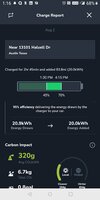I have this interesting observation and I am not able to reconcile all the data


- I had a starting charge of 70%, drove 60+ miles, and came back with a 45% charge remaining.
- Tesla Trips screen showed that I drove 61 miles and used 17kWh, average 276Wh/mi
- Immediately after reaching back, I charged back to 70%, and the Tesla app showed that 70% charging was completed, and used 22kWh
- Per the stats shown Tesla Trips screen, I used 25% of the charge capacity (70%-45%), hence derived total capacity is 68 kWh (17 / (25/100) )
- Per the Tesla app, it took 22kWh to go from 45% to 70%, and hence derived total capacity is 88 kWh (22 / (25/100) ). this doesn't match with the first calculation or the data available elsewhere (75kWh)
- Why does it show a loss of 17kWh to go from 70% to 45% and require 22kWh to go from 45% to 70%?



